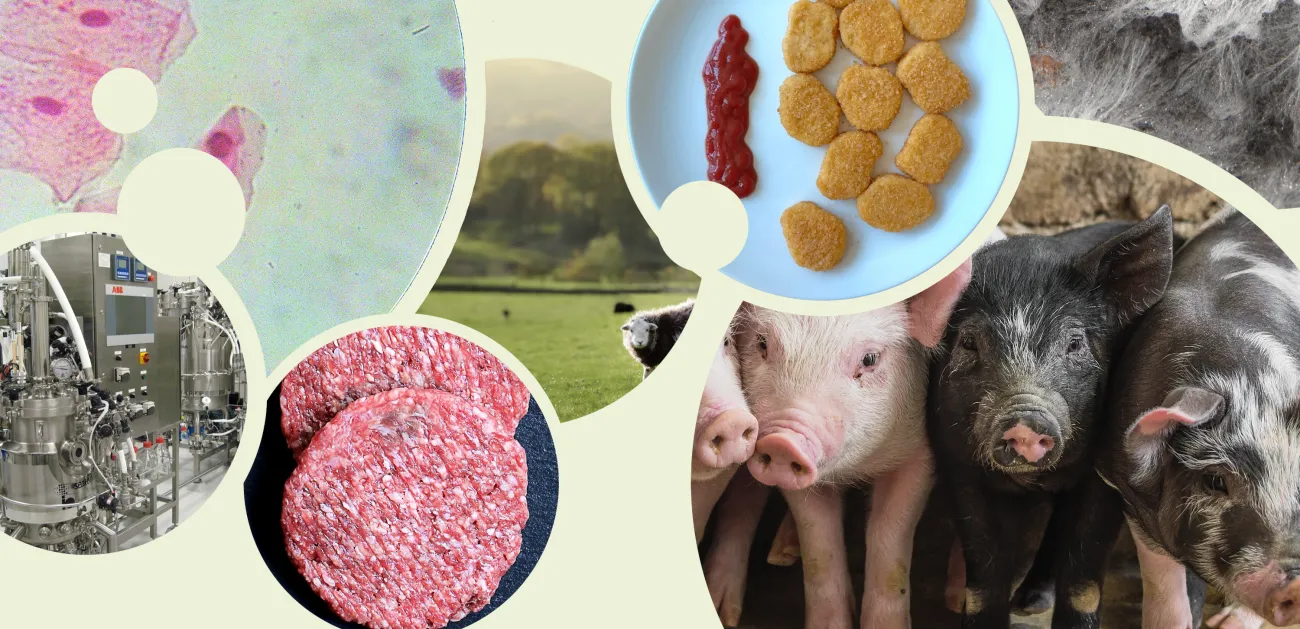This systematic review assesses the evidence base of the environmental and health impacts of novel plant-based foods (NPBFs) as compared to animal-based foods (ABFs) in food secure, high-income countries. NPBFs are defined by the researchers as new food products designed to mimic and replace ABFs and be added into habitual diets; examples include vegan meat or plant-based dairy. The researchers find that generally, NPBFs have better health outcomes and better environmental outcomes compared to ABFs. These results, however, vary by product type and context and they warn that caution should be given in the development of dietary guidelines. The authors suggest future research and policy should seek to develop more granular categories of NPBFs that account for these complex and often contextual health and environmental issues.

Summary
This systematic review article assesses the evidence base of the environmental and nutritional impacts of novel plant-based foods (NPBFs), or new food products designed to mimic and replace animal-based foods (ABFs) and be added into habitual diets The authors expand their argument from a base understanding that in general, in food-secure, high-income settings, shifting current dietary patterns away from ABFs towards diets rich in plant-based foods offers a viable pathway to improving nutritional health and environmental factors. They conclude that NPBFs typically have lower environmental impacts than ABFs. Additionally, whilst nutritional impacts are favourable on average for NPBFs, the findings are more complex and less generalizable. They suggest that future research and policies should seek to create more categories within NPBFs to address these varying and often contextual nutritional and environmental impacts.
The authors focus their analysis on food-secure and high-income settings and suggest that NPBFs, especially those designed to mimic and replace ABFs, could be a viable option to overcome barriers to the adoption of plant-based diets. These challenges relate to the need for additional cooking skills and consumer acceptance of changes to the taste and appearance of common food items.
Literature was systematically pulled from five scientific databases and grey literature was found using a systematic search on Google. A population, intervention (or exposure), comparison and outcomes (PICO) selection criteria was applied, which can be seen in Table 1. The authors include greenhouse gas emissions, land use, and blue-water footprint as their environmental selection criteria but do not include biodiversity or pollution metrics. The authors do note a major limitation is the lack of environmental evidence of NPBFs beyond these three metrics.
Table 1: Selection criteria for screened literature including population, intervention (or exposure), comparison and outcomes termed the PICO method. #
The authors find that generally, NPBFs are the healthier option in high-income settings due to their higher fibre content and lower levels of saturated fat and calorie content. They also highlight that specific NPBFs such as mycoprotein, or protein made from fungus, and legume-based meats contain more fruit, vegetables, legumes and/or nuts than others. Acceptance of products like these could help increase consumption issues of these foods in high-income settings.
The researchers found only nine studies which evaluated micronutrient data and found their content to range substantially across all groups of food items. For example, the median iron content for cereal- and grain- based plant based meats was significantly higher than that of meat and poultry. The authors do not specifically link this to fortification of NPBFs nor do they explicitly take into account the lower bioavailability of nonheme iron. They do note that more research is required to assess nutrient content and health risks related to bioavailability, bioaccessibility, and by-product formation during industrial processes. An additional example is that vitamin B12 levels were significantly lower in plant-based meats compared to meat and poultry. Whilst this was found on average across the 250 plant-based meat products compared to 24 ABFs, variation was significant, with some specific plant-based meats having a comparable or higher vitamin B12 content. The study provides further data on the macro and micronutrient content of plant-based drinks, yoghurts, and cheeses compared with the ABFs they mimic.
The researchers found that most studies reviewed found lower rates of greenhouse gas emissions and land use for plant-based meats compared to ABFs. They found legume based meats had a lower reduction in greenhouse gas emissions (86.1%) land use compared to nut and seed based meats (94.2%). Several studies also indicated higher rates of water use for plant-based meats than ABFs, although variation exists depending on what the plant-based meat is made of and the comparative animal farming system. The extent of the environmental impacts of NPBFs varies widely and is often context specific. The authors find marginal reductions in greenhouse gas emissions, land use and water use on average for plant-based foods compared to ABFs. However, many NPBFs also have worse environmental impacts in some contexts or in some impact categories, especially water use.
Interestingly, the researchers undertook a sensitivity analysis of the funding sources for the literature reviewed. They found that whilst funding sources did not significantly impact general trends found in the literature on environmental and health impacts of plant-based foods, there was variation. Industry funded research, typically from the NPBFs industry, generally found larger differences between NPBFs and ABFs than academy funded research.
The authors conclude by advising caution in the selection of NPBFs for dietary recommendations. Whilst in general they offer better health outcomes, many NPBFs, such as cereal and grain-based drinks and coconut-based cheese and yoghurts, can also have higher levels of sugar, sodium and saturated fats compared to ABFs. The environmental impacts vary even more widely and are context dependent, showing a less generalisable trend related to reductions of greenhouse gas emissions, land use and water use. The authors call for further research to provide more and better data on the environmental and health evidence for plant-based yoghurts, cheeses, and egg alternatives in particular and to expand the environmental considerations to include biodiversity loss and socioeconomic implications.
Abstract
Shifting from current dietary patterns to diets rich in plant-based (PB) foods and lower in animal-based foods (ABFs) is generally regarded as a suitable strategy to improve nutritional health and reduce environmental impacts. Despite the recent growth in supply of and demand for novel plant-based foods (NPBFs), a comprehensive overview is lacking. This review provides a synthesis of available evidence, highlights challenges, and informs public health and environmental strategies for purposeful political decision-making by systematically searching, analyzing, and summarizing the available literature. Five peer-reviewed databases and grey literature sources were rigorously searched for publications. Study characteristics meeting the inclusion criteria regarding NPBF nutrient composition and health and environmental outcomes in high-income countries were extracted. Fifty-seven peer-reviewed and 36 grey literature sources were identified; these were published in 2016–2022. NPBFs typically have substantially lower environmental impacts than ABFs, but the nutritional contents are complex and vary considerably across brands, product type, and main primary ingredient. In the limited evidence on the health impacts, shifts from ABFs to PB meats were associated with positive health outcomes. However, results were mixed for PB drinks, with links to micronutrient deficiencies. If carefully selected, certain NPBFs have the potential to be healthier and nutrient-rich alternatives to ABFs and typically have smaller environmental footprints. More disaggregated categorization of various types of NPBFs would be a helpful step in guiding consumers and key stakeholders to make informed decisions. To enable informed policymaking on the inclusion of NPBFs in dietary transitions as part of a wider net-zero and health strategy, future priorities should include nutritional food standards, labelling, and subdivisions or categorizations of NPBFs, as well as short- and long-term health studies evaluating dietary shifts from ABFs to NPBFs and standardized environmental impact assessments, ideally from independent funders.
Reference
Nájera Espinosa, S., Hadida, G., Jelmar Sietsma, A., Alae-Carew, C., Turner, G., Green, R., Pastorino, S., Picetti, R., Scheelbeek, P., 2024. Mapping the evidence of novel plant-based foods: a systematic review of nutritional, health, and environmental impacts in high-income countries. Nutrition Reviews nuae031.
Read more here. See also the TABLE explainer Meat, metrics and mindsets: Exploring debates on the role of livestock and alternatives in diets and farming and our podcast series Meat: the four futures




Comments (0)